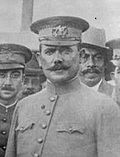Álvaro Obregón
Alvaro Obregón Salido (February 19, 1880 – July 17, 1928) was a Mexican farmer, warlord and general. He was one of the key players in the Mexican Revolution (1910-1920) and it is his election as President in 1920 that is considered by many as the ending point of the Revolution, although the violence continued afterwards. A brilliant and charismatic general, his rise to power is contributed to his effectiveness, ruthlessness, and the fact that he was the only one of the Revolution's “Big Four” still standing after 1923, as Pancho Villa, Emiliano Zapata and Venustiano Carranza all were assassinated.
Álvaro Obregón Media
Pascual Orozco (1882–1915), who fought with Francisco I. Madero (1873–1913) in 1910, only to launch a rebellion against him in Chihuahua in 1911. Obregón's first experience in the military was supporting pro-Madero forces under Victoriano Huerta (1850–1916) against Orozco's rebellion.
Gen. Obregón and staff of Yaquis, c. 1913
Álvaro Obregón (center left) and grey-bearded "First Chief" of the Constitutionalists, Venustiano Carranza.
Eulalio Gutiérrez (1881–1939), flanked by Francisco "Pancho" Villa (1878–1923) and Emiliano Zapata (1879–1919). Gutiérrez was appointed provisional President of Mexico by the Convention of Aguascalientes, a move that Venustiano Carranza (1859–1920) found intolerable. In the ensuing war, Obregón fought for Carranza against the convention.
General Álvaro Obregón (left) shown with a cigar in his left hand and his right arm missing, lost in the Battle of Celaya in 1915. Center is First Chief Venustiano Carranza
President Obregón in a business suit, showing that he lost his right arm fighting Pancho Villa in 1915. It earned him the nickname of El Manco de Celaya ("the one-armed man of Celaya").
Adolfo de la Huerta (1881–1955), the former Governor of Sonora under whose banner Obregón purportedly fought in 1920, and who served as Obregón's Finance Minister before launching a rebellion in 1923.










